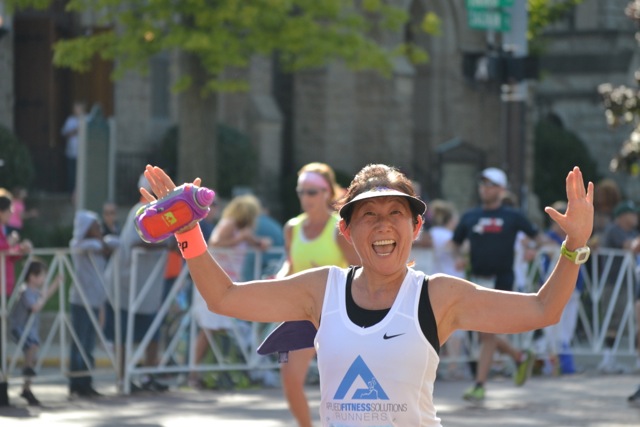“Bonk,” “Hit the Wall,” “Run out of Gas.” Whatever you call it, it’s the point that is every runner’s worst fear. You’re going along; feeling great, doing great and then all of a sudden it hits you, quite literally like you’ve run into a wall. Your legs get heavy, your pace slows, and reality sets in as you realize all your months of hard work are slipping away because you’ve effectively run out “gas.” If you’ve had this happen to you before, you know it’s a terrible feeling physically and mentally. The good news is this is one of the easiest aspects of running performance to address, and if you follow the three simple tips I will lay out in this article, not only will you NOT hit the wall, but you’ll jump over the top of it!
Before we get tips, let’s quickly establish what happens when you “hit the wall.” This point signifies the metabolic transition from the breakdown of carbohydrate as a fuel source to the breakdown of fat.
Now I know what you’re thinking; “I want my body to breakdown fat, don’t I?” Well, at rest you do, but during moderate-to-high intensity aerobic exercise, fat simply takes too long to breakdown (primarily because it’s not located directly in the muscle to be used as an energy source), whereas carbohydrate is available right inside of our muscles to be used as energy. The only problem is we have a limited storage space (“gas tank,” if you will) for carbohydrate. Once the gas in the tank is used up, we are forced to transition to a nutrient that breaks down more slowly, fat. When this happens, we have to reduce the speed at which muscles contract to give more time for fat to provide the body with energy. Simply put, carbs are fast acting fuels, fat is slow acting, so as soon as you transition to fat breakdown, your body forces you to slow down to give fat time to provide energy. This forced slowdown is when you “hit the wall.”
Now on to our tips:
Don’t prepare for a race and try to lose weight: Formal race prep (12-15 weeks before a race) is NOT time for weight loss. That should have occurred 15-30 weeks before the race. Your preparatory period can’t be a time of calorie restriction to induce weight loss, as this calorie restriction means carbohydrate restriction. This is sort of like taking your car on several long trips and never filling it back up with gas, eventually you run out of gas.
Consume at least 300-350 grams of carbs per day: We’ve been conditioned to think carbs are the enemy when they’re quite the opposite. They are the single most important fuel source for moderate-to-high intensity exercise. Furthermore, your running muscles must have at least 300 grams stored inside of them. That is your gas tank, and as a runner you have to refill it daily.
Nutrient timing: Consuming specific carb-protein sport beverages (like Accelerade, for example) before, during, and after exercise can have a profound impact on carbohydrate availability and utilization during exercise. Focusing on nutrient timing allows you to push carbohydrates to your active muscles at the most critical periods of a workout: before exercise to elevate blood sugar, during exercise to keep it high, and immediately after exercise to more effectively “refill” your carbohydrate “gas tank” after you run.
Although these solutions might seem simple, they are amazingly effective in their simplicity; even implementing one of these can have a huge impact on your performance. Implement all three and the sky really is the limit for you in your next race!
About the Author:
-

Michael Stack is the founder & CEO of Applied Fitness Solutions and Frontline Fitness Pros. He is a faculty lecturer for the University of Michigan’s School of Kinesiology. He is also the creator and the host of the Wellness Paradox Podcast, produced in conjunction with University of Michigan.
Michael is an exercise physiologist by training and a health entrepreneur, health educator, and fitness industry advocate by trade. He is dedicated to enhancing the standard of practice of, and advocating for, fitness and wellness professionals to ensure they become an essential constituent in the healthcare delivery system.
With a career spanning over three decades in fitness, health, and wellness Michael has a deep knowledge of exercise physiology, health/wellness coaching, lifestyle interventions to mitigate chronic disease and leadership. He is credentialed through the American College of Sports Medicine (ACSM) as an Exercise Physiologist (ACSM-EP), Exercise is Medicine practitioner (ASCM-EIM), and a Physical Activity in Public Health Specialist (ACSM-PAPHS). Michael is a National Strength & Conditioning Association (NSCA) Certified Strength & Conditioning Specialist (CSCS), and a CDC Diabetes Prevention Program (DPP) Lifestyle Coach.
Michael received his undergraduate degree from the University of Michigan’s School of Kinesiology in 2004 and is currently a Master’s of Public Health (MPH) candidate at University of Michigan, with a specific concentration in health behavior and health education.
Michael is a board of directors’ member for the Physical Activity Alliance and Michigan Fitness Clubs Association. He sits on the University of Michigan’s School of Kinesiology Alumni Board of Governors. Michael is an expert curriculum reviewer for the American College of Lifestyle Medicine. Finally, he is a member of the executive leadership team for American Heart Association’s Heart Walk.
Michael lectures nationally for several health/fitness certification and continuing educations, including; IHRSA, the Medical Fitness Association, the National Strength & Conditioning Association, and SCW Fitness.

